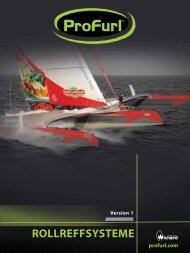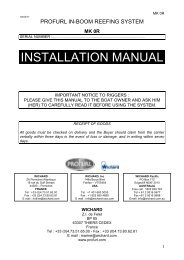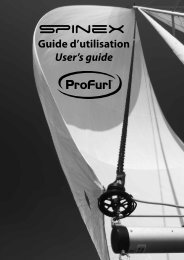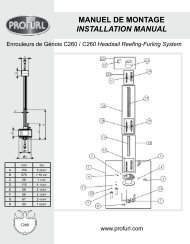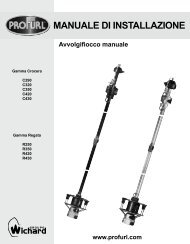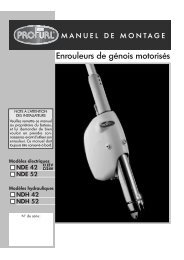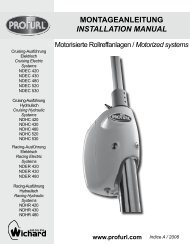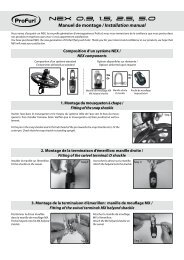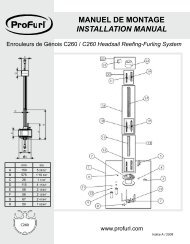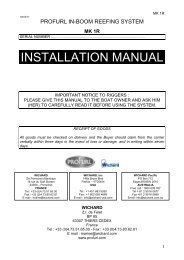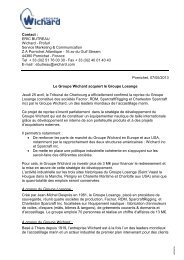Create successful ePaper yourself
Turn your PDF publications into a flip-book with our unique Google optimized e-Paper software.
I - GENERAL DESCRIPTIONNote : names in bold refer to parts identified on the exploded viewMK 3RThe <strong>PROFURL</strong> in-boom furling system includes :1. One set of luff profiles (1 and 2) articulated on the aft face of the mast .There are 2 different kinds of luff profiles : one 0.60 m long feeder profile (1) onwhich the feeder(3) is attached, and several 2 meters long normal luff profiles (2)depending on the mainsail’s luff length. One of these 2 meters long normal luffprofiles (2) will be re-cut to length at its upper end to match the expected luglength of the boat. The different luff profiles (1 et 2) are connected to each other bymean of connectors/articulations (4), which are connected to articulationbrackets (5) attached on the aft face of the mast.CAUTION : the articulation brackets (5) have a stainless steel pin. Check thedifference with end brackets (6), which have Nylon flanges.2. Articulation brackets (5) attached to the mast with 3 slide screws (7) slipped inthe mast track. Every slide screw (7) has a thread and a flat end going through ahole of the articulation brackets (5). The thread of the slide screws (7) receives alocknut (8) for attachment.3. Connectors/articulations (4) also used to connect the different luff profiles (1 and2), held by set screws (9). The lower end of the 0.60m long feeder profile (1) willbe connected on the gooseneck articulation (10), thus allowing the luff profiles (1and 2) to rotate together with the boom.4. A sheave box (11) through which the original mainsail halyard is passing. Thesheave box (11) will be fit at the top of the luff profiles (1 and 2). It is assembled onthe end brackets [2 times (6)], themselves being attached by mean of slide screws(7) and locknuts (8).5. The gooseneck (12a) and (12b) fit on the mast with 2 slide screws (7), and 2gooseneck plates (13) cambered at the mast shape before fitting, and which will beriveted onto the mast with the conical head pop rivets (14) supplied.6. A boom profile(15) which has been delivered upon request in 5 or 6 meters. It willprobably have to be re-cut to length when fitting to match the expected boom length.7. A mandrel (16) which turns on bearings (17 and 18) fit on a bearing holder (19)at the rear end of the boom, and on the drum bearing holder (21) front, turningaround a pin inserted in each of the boom end fittings (22 and 23). When recuttingthe boom profile (15) to length, the mandrel (16) should also be re-cut.8. A drum boom end fitting (22). It includes the drum (21) fit onto the mandrel (16):the drum being loaded with the furling line supplied, by pulling on the furling line andreleasing the mainsail halyard it will rotate the mandrel, which will furl the sail.9. 1 reinforced adjustable mainsheet bail (26) and 2 adjustable mainsheet bails (25).10. A special boomvang (27). It is attached :- onto the mast by mean of a boomvang attachment, including an gooseneck (12)attached onto the mast with 2 slide screws (7) locknuts (8) and 2 gooseneck plates(13) which will be riveted on the mast with pop rivets (14) with conical head supplied.The boomvang lower end will be attached onto an articulation eye (39) rotating in theboomvang gooseneck.- onto the boom with a boomvang hound (28).11. A ball bearing block (35) to lead the furling line (51) to the cockpit.4



